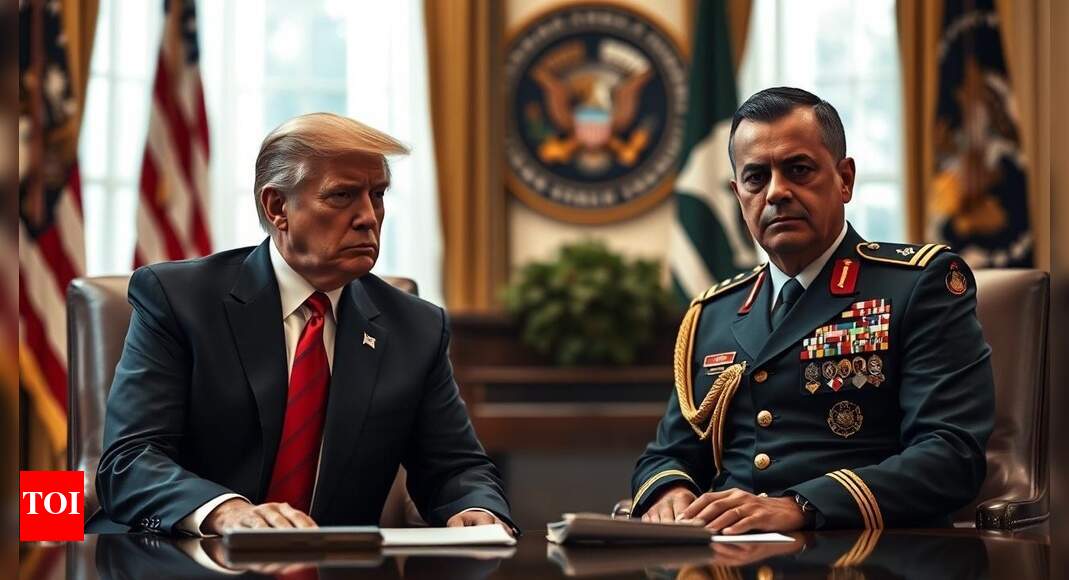Trump and Pakistan’s Army Chief: A Game-Changing Meeting with Global Implications!
ISLAMABAD — The recent meeting between US President Donald J. Trump and Pakistan’s Chief of Army Staff, Field Marshal Syed Asim Munir, has stirred significant interest among policymakers and analysts alike. Occurring at the White House, this high-profile dialogue seems to hold the potential for recalibrating strategic alliances in South Asia, particularly amid rising regional tensions.
A Geopolitical Power Play
What initially began as a routine one-hour lunch transformed into a two-hour marathon dialogue within the historic confines of the Oval Office. Participating in this critical juncture were Secretary of State Marco Rubio, Special Representative Steve Witkoff, and key figures from Pakistan, including National Security Advisor and Inter-Services Intelligence Chief, Lt Gen Asim Malik.
The agenda, as outlined by the Inter-Services Public Relations (ISPR), focused on counter-terrorism, trade, and peace. However, the underlying stakes appear far more complex, especially considering the recent backdrop of Israeli airstrikes on Iranian nuclear sites and ongoing tensions between India and Pakistan.
America’s Growing Interest in Pakistan
Ever the deal-maker, Trump has identified Pakistan as a strategic asset at a time when geopolitical dynamics are constantly shifting. Particularly, the shared border between Pakistan and Iran has heightened interest from Washington, especially as it seeks to exert influence in the region. Reports suggest that Trump pressed Munir for airspace access and intelligence on Tehran, leveraging Pakistan’s unique position as a mediator for U.S. interests in Iran.
In exchange for this critical intelligence, the American President allegedly proposed advanced weaponry and economic incentives designed to pull Islamabad away from its increasing ties with China and Russia’s BRICS alliance.
Economic and Military Implications
Trump’s objectives extend beyond mere military strategies; they include extensive economic engagement. His administration’s push to expand trade relations with Pakistan in critical minerals, cryptocurrency, artificial intelligence, and energy forms part of a larger design to integrate Pakistan into U.S.-led markets. This could also serve to stall China’s growing regional influence.
- Key Areas of Discussion:
- Counter-Terrorism: Pakistan’s military operations against Islamic State Khorasan (IS-K) align with U.S. interests in stabilizing Afghanistan.
- Military Assistance: Munir is rumored to have sought U.S. military and financial aid to modernize Pakistan’s defense forces, which could shift the balance of power vis-à-vis India if Trump agrees to supply advanced weapon systems.
- Economic Revitalization: Synchronizing economic initiatives with military collaborations could potentially stabilize Pakistan’s fragile economy, which has been grappling with various challenges.
The Indian Dimension
Conversations surrounding the Kashmir conflict and India were not far removed from the talks. With Munir previously playing a crucial role in brokering a ceasefire with India, this meeting is seen as a significant indicator of Islamabad’s diplomatic maneuvers. The Pakistan military chief emphasized the need for a U.S. role in de-escalating tensions between Iran and Israel, warning that prolonged instability could ripple throughout the region.
In a strategic gesture, Munir extended an invitation for Trump to visit Pakistan, aiming to reshape bilateral ties and elevate Pakistan’s status in international forums.
Conclusion: The Stakes Are High
The Trump-Munir summit symbolizes a fragile thaw in U.S.-Pakistan relations, driven by urgent economic needs and geopolitical recalibrations in South Asia. With China ramping up its influence and Iran facing military pressures, the implications of this meeting extend beyond bilateral ties to possibly redrawing the power dynamics in the region.
As nations observe the outcomes of this pivotal encounter, the question remains: will Trump’s ambitious agenda translate into a realignment of strategic alliances that positions Pakistan as a cornerstone of U.S. policy in South Asia? For India, the convergence of U.S. interests with Pakistan’s military ambitions may necessitate a recalibration of its own strategies, as the regional chess game intensifies.
Such developments warrant vigilant observation, as the ramifications could reshape not just South Asia’s geopolitical landscape but also the broader narrative of U.S. engagement in global conflicts.
In this new chapter of U.S.-Pakistani diplomacy, the stakes couldn’t be higher—both for regional stability and for the strategic interests of global powers at play. The world watches closely as this story unfolds.




